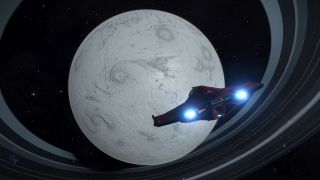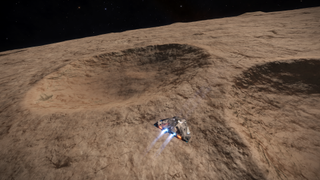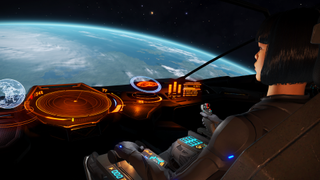The mind-bending science behind the planets of Elite Dangerous
Frontier reveals its secrets.

When you see a planet in Elite Dangerous, you could be forgiven for thinking it was just a big sphere with a texture wrapped around it. But everything in the game’s Milky Way is generated according to real science by a system called the Stellar Forge, and a dizzying amount of data goes into generating those beautiful alien worlds. I asked Frontier to explain how it all works.
“Before a planet can be made, you must first simulate the circumstances of its birth,” says Dr. Kay Ross, senior programmer. “And to know what planet you’re creating, you must first know what materials went into making it, how old it is, what its neighbours are doing, and which stars are nearby.”
Planets begin life as a disc orbiting with a a newly formed star at its centre. “The disc has material density and temperature information which reflects how lighter materials tend to get pushed further away from the star by the radiation pressure,” says Ross. “This has an iterative process applied to it as epochs of time are simulated, based on the rough known age of the system.”
Stable orbits are then determined for objects formed from the materials in the disc clumping together. Passing comets and rogue planets are also thrown into the mix, to disrupt the orbits and create fledgling planets and moons.

“The end point of this process provides information for potentially complex orbital systems, with co-orbiting or binary planets possible, and all sorts of potential moon layouts,” says Ross. “Each body has an amount of different gases, liquids, and solids collected, and chemical reactions are applied based on their temperature. These will also depend on the star’s properties, to determine if those liquids or gases would be stable at those orbital distances, and how much energy is applied to the system.”
The planets created through this process can finally be classified depending on the resulting remaining atmosphere, surface liquids, ground and tidal activity, be it a gas giant or a terrestrial world. “And all of this," says Ross. "Happens in a fraction of a second on your CPU."
To help model the Milky Way accurately, Ross consulted scientific research papers. “I looked at data on the estimated mass of the Milky Way, the density, age, and masses of stars across the different parts of it, and the rates of stellar and planetary evolution during the lifetime of the system,” says Ross. “My background as a scientist helped here.”
The biggest gaming news, reviews and hardware deals
Keep up to date with the most important stories and the best deals, as picked by the PC Gamer team.
The Hipparcos and Gliese star catalogues were particularly helpful, providing Ross with useful information about observable stars in the Milky Way. “As long as we have information on the position of a star and its apparent luminosity, we can fill in the gaps of information by calculating the range of properties it might have. For example, we can infer a probable radius and surface temperature from the its classification, colour, and brightness.”

I ask Ross if obeying the laws of physics so closely limits creativity. “Physics can already provide a vast range of outcomes for us to work with and build upon. Elite Dangerous is based on our Milky Way and I personally feel that to push far into the implausible detracts from the wonder and connection this brings. We’re still actively developing the game, and there is still a vast amount of natural wonder waiting to be brought into the game.”
But the planets in Elite aren’t completely computer generated. The Stellar Forge lays the groundwork, but Ross says it’s also a collaborative effort between the render programmers and art department. “This arrangement works very well. The engine generates topological features from high orbit down to human scale, but the artists deserve a lot of praise for adding in fine material detail and flair. They can also inject custom topography into sites on planets for gameplay, story, and/or settlement related reasons.”
As for what lies ahead for Elite's planets, Ross says Frontier hopes to push the capabilities and fidelity of planetary terrain. “This has already begun with redistributing the materials and colours for rocky planets in the 3.0 release. We’re also giving our icy planets a facelift for the Beyond Chapter 4 update, including revisiting the topology of the terrain and the density and variety of detail items scattered across the surfaces.”

If it’s set in space, Andy will probably write about it. He loves sci-fi, adventure games, taking screenshots, Twin Peaks, weird sims, Alien: Isolation, and anything with a good story.
Most Popular


